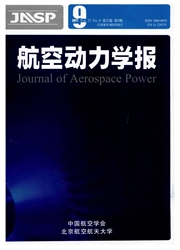

 中文摘要:
中文摘要:
基于国产动力约束及隐身设计要求,针对飞翼布局无人机双发动机布局进行了保形S弯进气道设计,为进一步提高进气道性能,开展了进气道优化设计研究.首先利用CFD(计算流体动力学)方法对保形进气道风洞模型进行验证,然后结合参数化建模和网格自动生成技术进行CFD数值模拟,最后利用RBF(radial basis function neural network)代理模型及多岛遗传算法开展进气道优化设计.结果表明:1优化后进气道性能有所改善,尤其表现在4°迎角之后性能明显提升,Ma=0.6下4°迎角时总压恢复系数提高了5.46%,畸变指数降低了38.7%;2优化后进气道截面积分布相比初始构型在前段更缓和而后段略微升高,中心线则在前1/3段与初始构型基本一致,之后曲率变化更加平缓;3保形进气道在出口截面具有较强的二次流,侧滑角对于此类进气道在小迎角下影响较小而大迎角时影响较大,设计时应关注大迎角时侧滑特性.
 英文摘要:
英文摘要:
Based on domestic power constraint and stealth design requirements, conformal S-shaped inlet was designed for twin-engine flying wing unmanned aerial vehicle. In order to further improve the inlet performance, the optimization research on the inlet design was carried out. First, a verification on the wind tunnel test model of conformal inlet was made by CFD (computational fluid dynamics). And then CFD numerical simulation was carried out combining with parametric modeling and automatic mesh generation technique. Fi- nally, RBF (radial basis function neural network) surrogate model and multi-island genetic algorithm were used to take an optimization on the inlet parameters. Results indicated: (1) The aerodynamic performance of optimized inlet improved, and especially it improves significantly after the attack angle of 4°. The total pressure recovery coefficient increased by 5. 46%, and the distortion coefficient decreased by 38.7% at the Mach number of 0.6 and attack angle of 4°. (2) Compared to the initial configuration, the area distribution of optimized inlet changed gently in the front but increases slightly behind; while the centerline of former 1/3 was consistent with the initial configuration, and after that the curvature changed more smoothly. (3) The conformal inlet has strong secondary flow at the exit. The sideslip angle made a little influence on the inlet performance under small attack angle but it had greater influence at large attack angle. So the sideslip performance under large attack angle should be paid more attention.
 同期刊论文项目
同期刊论文项目
 同项目期刊论文
同项目期刊论文
 期刊信息
期刊信息
